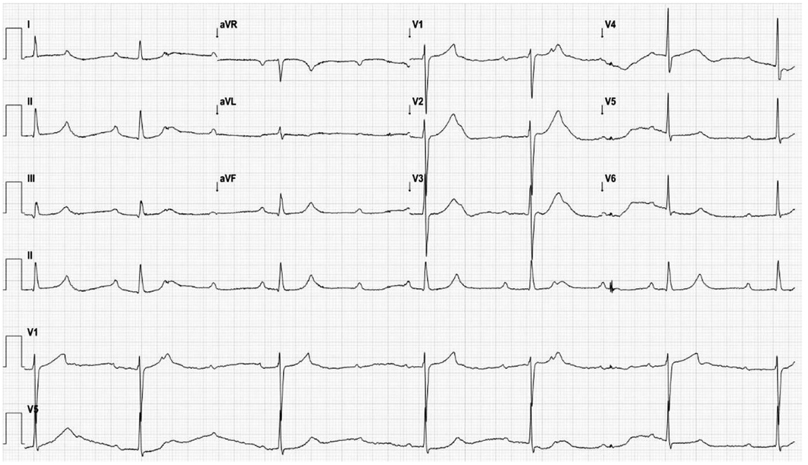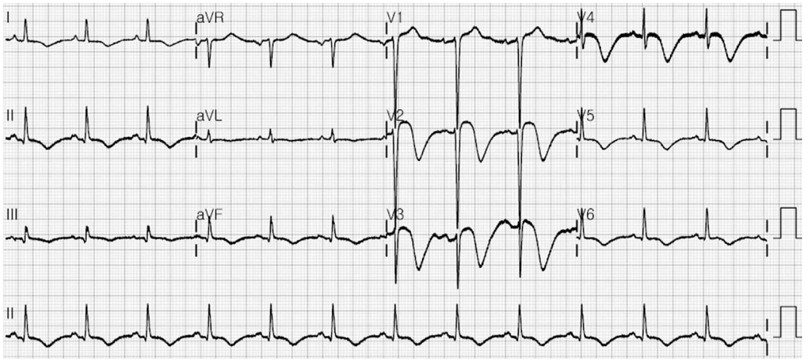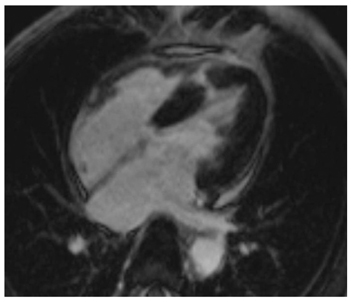Korean Circ J.
2011 Oct;41(10):625-628. 10.4070/kcj.2011.41.10.625.
Delayed Ventricular Septal Rupture Following Blunt Chest Trauma
- Affiliations
-
- 1Department of Internal Medicine, Gyeongsang National University Hospital, Jinju, Korea. parkjrang@gmail.com
- 2Department of Radiology, Gyeongsang National University Hospital, Jinju, Korea.
- KMID: 2297925
- DOI: http://doi.org/10.4070/kcj.2011.41.10.625
Abstract
- Cardiac injury is a common but occasionally serious complication of blunt chest trauma. A ventricular septal rupture (VSR) is a rare complication and is variable in its presentation, temporal course and severity. Here, we report a rare case of 75-year-old man who developed delayed VSR following blunt chest trauma.
Figure
Reference
-
1. Hamdan-Challe M, Godin M, Bouchart F, Doguet F. Isolated ventricular septal rupture secondary to blunt trauma. Interact Cardiovasc Thorac Surg. 2010. 11:667–669.2. Fang BR, Li CT. Acute myocardial infarction following blunt chest trauma. Eur Heart J. 1994. 15:705–707.3. Blasco PB, Comas JG, del Alcazar Munoz R. Spontaneous improvement of a haemodynamically significant ventricular septal defect produced by blunt chest trauma in a child. Cardiol Young. 2009. 19:109–110.4. Genoni M, Jenni R, Turina M. Traumatic ventricular septal defect. Heart. 1997. 78:316–318.5. Dehghani P, Ibrahim R, Collins N, Latter D, Cheema AN, Chisholm RJ. Post-traumatic ventricular septal defects: review of the literature and a novel technique for percutaneous closure. J Invasive Cardiol. 2009. 21:483–487.6. Cleland WP, Ellman P, Goodwin J, Hollman A. Repair of ventricular septal defect following indirect trauma. Br J Dis Chest. 1961. 55:17–22.7. Jun SL, Chanani NK, Moore P, Higgins CB. Magnetic resonance imaging of a posttraumatic myocardial infarction and ventricular septal defect with a closure device in place. Circulation. 2007. 115:e13–e15.8. Pesenti-Rossi D, Godart F, Dubar A, Rey C. Transcatheter closure of traumatic ventricular septal defect: an alternative to surgery. Chest. 2003. 123:2144–2145.9. Sakka SG, Huettemann E, Giebe W, Reinhart K. Late cardiac arrhythmias after blunt chest trauma. Intensive Care Med. 2000. 26:792–795.10. Helling TS, Duke P, Beggs CW, Crouse LJ. A prospective evaluation of 68 patients suffering blunt chest trauma for evidence of cardiac injury. J Trauma. 1989. 29:961–966.11. Yun HJ, Jin SW, Ahn YY, et al. A case of isolated ventricular septal rupture following non-penetrating chest trauma. J Korean Soc Echocardiogr. 2001. 9:157–160.12. Lee WS, Lee IK, Kim KS, Kim YN, Kim KB. A case of traumatic ventricular septal defect secondary to nonpenetrating chest trauma. Korean Circ J. 1987. 17:381–387.
- Full Text Links
- Actions
-
Cited
- CITED
-
- Close
- Share
- Similar articles
-
- A Case of Isolated Ventricular Septal Rupture Following Non-penetrating Chest Trauma
- A Case of Traumatic Ventricular Septal Defect Secondary to Nonpenetrating Chest Trauma
- Conventional and Transesophageal Echocardiographic Demonstration of a Ventricular Septal Perforation with Bilateral Shunt and Chordae Rupture of Tricuspid Septal Leaflet Caused by Nonpenetrating Chest Trauma: A Case Report
- A Case of Left Ventricular Rupture and Complete Rupture of both Papillary Muscles Following Blunt Chest Trauma
- Interventricular Septum Rupture due to Blunt Chest Trauma: A Case Report






